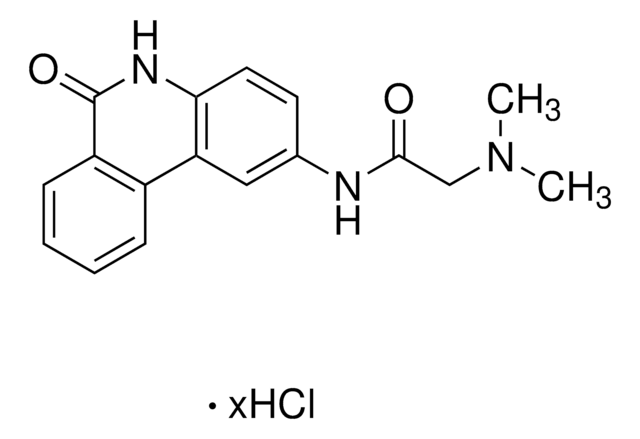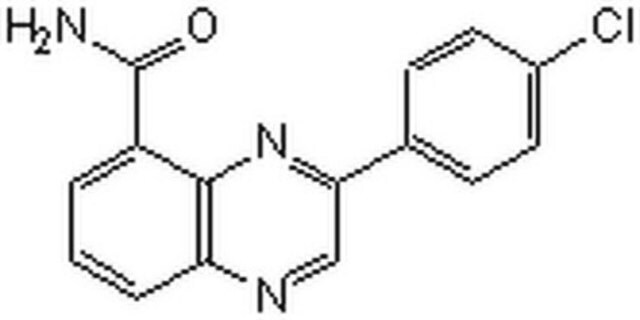Key Documents
P4365
PJ-34 hydrochloride hydrate
≥98% (HPLC), powder
Synonim(y):
PARP Inhibitor VIII, PJ 34 HCl, N-(6-Oxo-5,6-dihydrophenanthridin-2-yl)-(N,N-dimethylamino)acetamide hydrochloride
About This Item
Polecane produkty
Poziom jakości
Próba
≥98% (HPLC)
Postać
powder
warunki przechowywania
desiccated
kolor
white to yellow
rozpuszczalność
H2O: 22 mg/mL
ciąg SMILES
Cl[H].[H]O[H].CN(C)CC(=O)Nc1ccc2NC(=O)c3ccccc3-c2c1
InChI
1S/C17H17N3O2.ClH.H2O/c1-20(2)10-16(21)18-11-7-8-15-14(9-11)12-5-3-4-6-13(12)17(22)19-15;;/h3-9H,10H2,1-2H3,(H,18,21)(H,19,22);1H;1H2
Klucz InChI
YCALIZUKAFUQCH-UHFFFAOYSA-N
Zastosowanie
- as a poly(ADP-ribose) polymerase (PARP) inhibitor 1 in rats to test the effect of PAPR1 in neuropathic pain
- as a component of protein extraction buffer to enable visualization of the high-molecular-weight smear of PARylated proteins in various cell samples
- as PARP inhibitor in murine MLE-12 epithelial cell line
Działania biochem./fizjol.
Kod klasy składowania
11 - Combustible Solids
Klasa zagrożenia wodnego (WGK)
WGK 3
Temperatura zapłonu (°F)
Not applicable
Temperatura zapłonu (°C)
Not applicable
Środki ochrony indywidualnej
Eyeshields, Gloves, type N95 (US)
Certyfikaty analizy (CoA)
Poszukaj Certyfikaty analizy (CoA), wpisując numer partii/serii produktów. Numery serii i partii można znaleźć na etykiecie produktu po słowach „seria” lub „partia”.
Masz już ten produkt?
Dokumenty związane z niedawno zakupionymi produktami zostały zamieszczone w Bibliotece dokumentów.
Nasz zespół naukowców ma doświadczenie we wszystkich obszarach badań, w tym w naukach przyrodniczych, materiałoznawstwie, syntezie chemicznej, chromatografii, analityce i wielu innych dziedzinach.
Skontaktuj się z zespołem ds. pomocy technicznej







